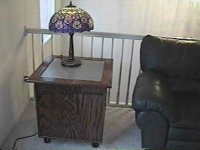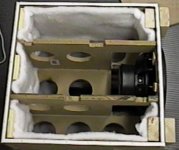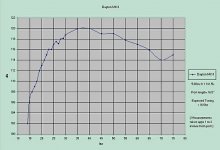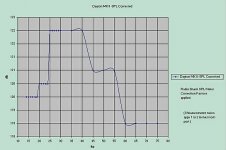Hi,
I'm building a 12" MKII in a 5 cu.ft. enclosure. Amp is the 300-794 (250 watt). Bottom firing and port is also located on the bottom.
Does the amp need to be enclosed?
If not, I am planning to mount the amp to the back of the cabinet and leave the internals of the amp open to the inside of the enclosure.
I will be using a 4"x 15" flared port.
Does the port need any support?
The port only has 4 mounting holes on 1 of the flared ends. This leaves the 15 inches freestanding in the enclosure.
Is this ok?
Thanks,
Chris
I'm building a 12" MKII in a 5 cu.ft. enclosure. Amp is the 300-794 (250 watt). Bottom firing and port is also located on the bottom.
Does the amp need to be enclosed?
If not, I am planning to mount the amp to the back of the cabinet and leave the internals of the amp open to the inside of the enclosure.
I will be using a 4"x 15" flared port.
Does the port need any support?
The port only has 4 mounting holes on 1 of the flared ends. This leaves the 15 inches freestanding in the enclosure.
Is this ok?
Thanks,
Chris
CJ.9:
Your quote: I'm building a 12" MKII in a 5 cu.ft. enclosure. Amp is the 300-794 (250 watt).
LOL, you might have mentioned that you meant the Parts Express Dayton Titanic 12" Mk II and that 300-794 was a Parts Express number. Actually, Parts Express gets mentioned so often in this forum that it is not that big a deal.
As stated previously, those sub amps are designed to be mounted just as you were planning.
Suggestion: As long as you are going up to a 5 cu ft enclosure, consider tuning the box to 16 Hz. This would give you a port of 4" X 23". 4" elbows are available at Home Depot and similar stores if you need to bend the port to fit in the enclosure.
Why do this? It doesn't take too much away at 20 Hz, and will give you the ability to go down to 16 Hz.
Back in the eighties, a researcher found that at the time, there were only FIVE CD's in existence that had usable sound below 16 Hz. So any subwoofer that can play down to 16 Hz has all but 5 CD's covered.
It's not a necessity, you can stay with the 15" long port if you want. But it is just something to consider.
Your quote: I'm building a 12" MKII in a 5 cu.ft. enclosure. Amp is the 300-794 (250 watt).
LOL, you might have mentioned that you meant the Parts Express Dayton Titanic 12" Mk II and that 300-794 was a Parts Express number. Actually, Parts Express gets mentioned so often in this forum that it is not that big a deal.
As stated previously, those sub amps are designed to be mounted just as you were planning.
Suggestion: As long as you are going up to a 5 cu ft enclosure, consider tuning the box to 16 Hz. This would give you a port of 4" X 23". 4" elbows are available at Home Depot and similar stores if you need to bend the port to fit in the enclosure.
Why do this? It doesn't take too much away at 20 Hz, and will give you the ability to go down to 16 Hz.
Back in the eighties, a researcher found that at the time, there were only FIVE CD's in existence that had usable sound below 16 Hz. So any subwoofer that can play down to 16 Hz has all but 5 CD's covered.
It's not a necessity, you can stay with the 15" long port if you want. But it is just something to consider.
Consider a forward firing configuration...I have heard horror stories of down firing subs that start to sag. Just a suggestion...
-andy
-andy
Thanks for the response guys... I had completed the sub before your posts. 🙁
I hope I don't have any problems with the downfiring position.
I do have another question... How much stuffing (if any) should I fill the enclosure with?????
I lined the inside surfaces with 1" poly .
I had closed the box with no insulation on the inside surfaces and fired it up. Sounded pretty bad. After adding the layer of poly , it sounded much better.
Should I add additional polyfill stuffing to the box?
Thanks,
Chiris
I hope I don't have any problems with the downfiring position.
I do have another question... How much stuffing (if any) should I fill the enclosure with?????
I lined the inside surfaces with 1" poly .
I had closed the box with no insulation on the inside surfaces and fired it up. Sounded pretty bad. After adding the layer of poly , it sounded much better.
Should I add additional polyfill stuffing to the box?
Thanks,
Chiris
Complete Dayton Titanic MK II 12"
Well, I finally finished. Whew! I think I can park in the garage again.
I would like to thank everyone on this board for helping with the questions .
I hope these photos come out ok.
Well, I finally finished. Whew! I think I can park in the garage again.
I would like to thank everyone on this board for helping with the questions .
I hope these photos come out ok.
OK, cool! COOL! COOL! Right now for my cheap, just get it to work HT in the basement I have: Two Technics SB-2822s with the mid and tweet disabled so the sub is working the bass, however, crossing over at 1600Hz. What the hell? Oh yeah, the weak mid-range needs help up there anyway. So....those cabinets are hiding under some glass-top tables with lamps on them...hmmm?? Hows about making the sub like yours?? Yes!
Thank you for your kind words Mr. Kelticwizard.
I think I may need further assistance (read: more stupid questions)
How do I evaluate the outcome?
Is there a computer program that I can mike into , run a test cd?
I'm afraid I'm not very objective after working on this thing for a couple of weeks. Sounds great to me but I don't think thats very scientific.
I don't have much for sound test gear, just a radio shack spl meter.
Thanks,
Chris
I think I may need further assistance (read: more stupid questions)
How do I evaluate the outcome?
Is there a computer program that I can mike into , run a test cd?
I'm afraid I'm not very objective after working on this thing for a couple of weeks. Sounds great to me but I don't think thats very scientific.
I don't have much for sound test gear, just a radio shack spl meter.
Thanks,
Chris
Cj.9:
These are not stupid questions. These are sensible questions.
Freeware: NCH tone generator-set it to "sine wave". You need not be stuck with the preset tones. Instead of clicking the arrow in the Frequency box to move up and down between preset tones, you can write in your own frequencies! Just highlight the Frequency box in blue and write in whichever frequency you want.
http://www.nch.com.au/tonegen/index.html
WinISD is a free speaker simulation program that has it's own tone generator. This one can sweep down by itself-you might find it more useful than the NCH.
http://www.linearteam.dk/winisd.html
More freeware: Speaker Workshop is a program with all kinds of testing capabilities. I haven't set it up yet, but people who have done so rave about it.
http://www.speakerworkshop.com/
I think there is a website somewhere with the response curve of the Radio Shack SPL meter. I might get back to you on that. You should be able to use it well enough anyway. If you use Speaker Workshop, you might not need the SPL meter anyway-just a computer mic.
Your sub is in a rather odd position, next to a stairwell. For measurement puposes, maybe you can move it to a larger room with a floor all around it. Keep the sub where you want of course, (it's your house, LOL), but whatever measurements you might make with the sub in that position are likely to be somewhat off.
You might try measuring the tone at which the port's output is highest. This is the tuning frequency. Just put your mic/SPL meter right up to the port and run the test tones. It will tell you if the box is tuned properly. Of course, there are other tests you will want to run.
Again, great job!! It is one snazzy sub/endtable!!
These are not stupid questions. These are sensible questions.
Freeware: NCH tone generator-set it to "sine wave". You need not be stuck with the preset tones. Instead of clicking the arrow in the Frequency box to move up and down between preset tones, you can write in your own frequencies! Just highlight the Frequency box in blue and write in whichever frequency you want.
http://www.nch.com.au/tonegen/index.html
WinISD is a free speaker simulation program that has it's own tone generator. This one can sweep down by itself-you might find it more useful than the NCH.
http://www.linearteam.dk/winisd.html
More freeware: Speaker Workshop is a program with all kinds of testing capabilities. I haven't set it up yet, but people who have done so rave about it.
http://www.speakerworkshop.com/
I think there is a website somewhere with the response curve of the Radio Shack SPL meter. I might get back to you on that. You should be able to use it well enough anyway. If you use Speaker Workshop, you might not need the SPL meter anyway-just a computer mic.
Your sub is in a rather odd position, next to a stairwell. For measurement puposes, maybe you can move it to a larger room with a floor all around it. Keep the sub where you want of course, (it's your house, LOL), but whatever measurements you might make with the sub in that position are likely to be somewhat off.
You might try measuring the tone at which the port's output is highest. This is the tuning frequency. Just put your mic/SPL meter right up to the port and run the test tones. It will tell you if the box is tuned properly. Of course, there are other tests you will want to run.
Again, great job!! It is one snazzy sub/endtable!!
Would it matter where the crossover is set when doing the box tuning test?
Also the amp volume should be max ,right?
Would there be any obvious reason the box tuning would be a lot higher than anticipated??? 🙁
Chris
Also the amp volume should be max ,right?
Would there be any obvious reason the box tuning would be a lot higher than anticipated??? 🙁
Chris
Stuffing is 1" polyfill sheets on the walls and about 1lb. of polyfill
pillow type stuffing to fill the enclosure.
Also , if I apply the Radio Shack SPL meter correction factor from Eric Bush and Dave Clark and others (ref. PSACS Sound Bytes articles) then the graph looks pretty flat from 40 hz. down to 25 hz. then drops to 2 db at 20 and 2.5 db at 16hz.
Correction numbers used are as follows:
" These are corrections, they are to be added to the meter readout for the correct response in dB SPL."
10Hz +20.5
12.5Hz +16.5
16Hz +11.5
20Hz +7.5
25Hz +5
31.5Hz +3
40Hz +2.5
50Hz +1.5
63Hz +1.5
80Hz +1.5
100Hz +2
125Hz +0.5
160Hz -0.5
200Hz -0.5
250Hz +0.5
315Hz -0.5
400Hz 0
500Hz -0.5
630Hz 0
800Hz 0
1KHz 0
1.25Khz 0
1.6KHz -0.5
2Khz -1.5
2.5Khz -1.5
3.15Khz -1.5
4KHz -2
5KHz -2
6.3KHz -2
8KHz -2
10Khz -1
12.5KHz +0.5
16KHz 0
20KHz +1
As you can see, the correction #''s are pretty large at the lower freq's.
I measured the levels at about 2" from the port . Actual DB's read by meter were from 108 to 120.
Am I way off track here??
Thanks
Chris
pillow type stuffing to fill the enclosure.
Also , if I apply the Radio Shack SPL meter correction factor from Eric Bush and Dave Clark and others (ref. PSACS Sound Bytes articles) then the graph looks pretty flat from 40 hz. down to 25 hz. then drops to 2 db at 20 and 2.5 db at 16hz.
Correction numbers used are as follows:
" These are corrections, they are to be added to the meter readout for the correct response in dB SPL."
10Hz +20.5
12.5Hz +16.5
16Hz +11.5
20Hz +7.5
25Hz +5
31.5Hz +3
40Hz +2.5
50Hz +1.5
63Hz +1.5
80Hz +1.5
100Hz +2
125Hz +0.5
160Hz -0.5
200Hz -0.5
250Hz +0.5
315Hz -0.5
400Hz 0
500Hz -0.5
630Hz 0
800Hz 0
1KHz 0
1.25Khz 0
1.6KHz -0.5
2Khz -1.5
2.5Khz -1.5
3.15Khz -1.5
4KHz -2
5KHz -2
6.3KHz -2
8KHz -2
10Khz -1
12.5KHz +0.5
16KHz 0
20KHz +1
As you can see, the correction #''s are pretty large at the lower freq's.
I measured the levels at about 2" from the port . Actual DB's read by meter were from 108 to 120.
Am I way off track here??
Thanks
Chris
Cj.9:
The best way to measure the output from the port is to put the mic/SPL meter directly in front of it, flush with the front of the box. The power does not have to be anywhere near full-in fact, less than a watt will be fine. The curve does not change with additional power. Only the volume goes up with additional power. The curve-the relative volume between different frequencies-will remain the same. So a nice small tone is all you need.
A ported box should not be filled with loose stuffing. That is for closed boxes only. A ported box depends on the free flow interchange between the air in the enclosure and the port-no obstructions. You could line the walls of the enclosure with some more polyfill if you want, though. In a large enclosure, one inch or two inches doesn't much matter-as long as the main interior area of the enclosure is free and clear.
This does not apply to a transmission line enclosure, which is an enclosure type that also has significant output from an opening in the box. Those are stuffed. However, the transmission line works on very different principles from a ported, or bass reflex, box, which is what you have.
PS: Nice bracing job!
The best way to measure the output from the port is to put the mic/SPL meter directly in front of it, flush with the front of the box. The power does not have to be anywhere near full-in fact, less than a watt will be fine. The curve does not change with additional power. Only the volume goes up with additional power. The curve-the relative volume between different frequencies-will remain the same. So a nice small tone is all you need.
A ported box should not be filled with loose stuffing. That is for closed boxes only. A ported box depends on the free flow interchange between the air in the enclosure and the port-no obstructions. You could line the walls of the enclosure with some more polyfill if you want, though. In a large enclosure, one inch or two inches doesn't much matter-as long as the main interior area of the enclosure is free and clear.
This does not apply to a transmission line enclosure, which is an enclosure type that also has significant output from an opening in the box. Those are stuffed. However, the transmission line works on very different principles from a ported, or bass reflex, box, which is what you have.
PS: Nice bracing job!
- Status
- Not open for further replies.
- Home
- Loudspeakers
- Multi-Way
- Sub Help




